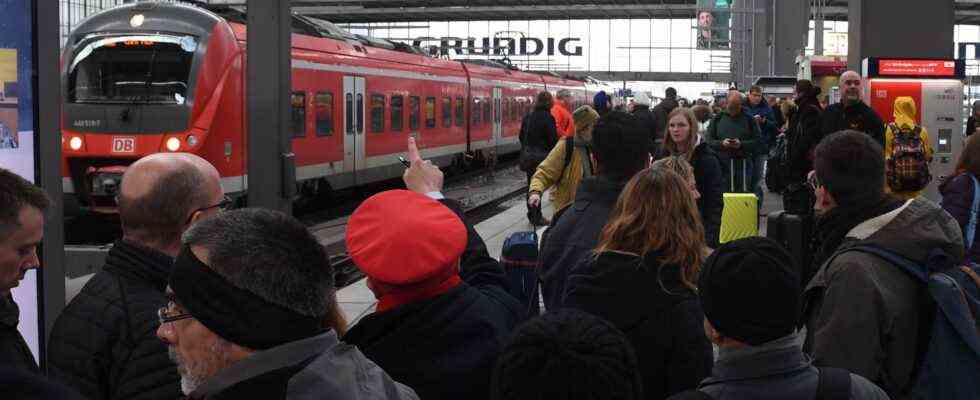FAQ
Status: 08/10/2021 3:52 p.m.
The GDL implements its strike plans at unusually short notice. Travelers must expect significant restrictions. How badly will rail traffic be disrupted – and what can rail customers do now?
Vacationers and commuters have to expect train cancellations and delays from Wednesday night due to strikes by the train drivers’ union GDL at Deutsche Bahn. It is the first strike at Deutsche Bahn since December 2018, when the competing trade union EVG called on its members to take part in a labor dispute. The GDL strike was much harder in 2014 and 2015. Although the GDL is significantly smaller than the EVG, it represents around 80 percent of DB train drivers.
How serious is the strike that has now been announced?
This time, the unusually short-term strike should apply to passenger trains and the entire railway infrastructure from this Wednesday at 2 a.m. and end on Friday at 2 a.m. Experience has shown that the restrictions are likely to drag on well into Friday. The following weekend should be spared, announced the GDL.
Deutsche Bahn has already drawn up replacement timetables for local and long-distance traffic. She announced that only every fourth long-distance train will run. Restrictions must also be expected in local transport. The company advised everyone “who doesn’t have to drive” to postpone their trip if possible.
The updated timetable should be available on the website www.bahn.de from this afternoon. The railway also set up a free strike hotline on 08000-996633, which should also be available from the afternoon.
Which connections will be particularly affected?
As far as possible, heavily frequented routes and connections to important train stations and airports are to be served, explained Deutsche Bahn. During the last GDL strike six years ago, around a third of the long-distance trains were able to run, especially on the main routes from the Ruhr area to the east and from Hamburg to the south. Most of the trains also failed in regional traffic and on S-Bahn trains.
The disrupted operations are also likely to lead to restrictions among competitors of Deutsche Bahn.
Is there a new, long wave of strikes looming?
The GDL has already emphasized its determination to organize “long, long strikes”. “But we do not intend to enjoy it,” it said. The union wants to make further strikes beyond Friday dependent on the behavior of employers. The railway believes an agreement on the “material demands is possible” and called the GDL back to the negotiating table. Detlef Neuss from the Pro Bahn passenger association believes further outstanding debts “until mid-August” and beyond are quite conceivable, depending on the progress of the negotiations.
During the extremely tough labor dispute between the GDL and the railways in 2014 and 2015, the train drivers paralyzed large parts of the route network in eight increasing waves. This time, however, the prerequisites for such a serious conflict are not in place. Due to the severe restrictions in the pandemic and, most recently, the flood disaster, the railway is noticeably damaged. After a horrific loss in the Corona year 2020 of almost six billion euros, it was still 1.4 billion in the first half of 2021.
In view of the current tension in supply chains caused by the crisis, an extended wave of strikes would also seriously threaten the economic situation. This puts both parties under additional pressure to reach an agreement. In the current situation, public acceptance of the strikes is likely to be even lower than before.
What are the options for travelers?
As a gesture of goodwill, the railway extended the validity of the tickets for the strike period until August 20. A free reimbursement of train tickets is also possible, and Deutsche Bahn has recently started offering a less tedious online process. In addition, the train connection for saver fares was lifted for the strike period.
In view of the distance rules that still apply in the seating area, the remaining trains are likely to have cramped conditions in the standing areas. Detlef Neuss from Pro Bahn believes it is impossible that the minimum distance of 1.5 meters in the trains can be maintained under these conditions. However, studies have shown that the risk of infection on trains is limited.
Neuss advises affected passengers to form car pools or to talk to their employers about a home office solution. Long-distance buses are also an alternative, but capacities can hardly be expanded at such short notice.
What is the collective bargaining dispute about?
The GDL had already declared the month-long tariff talks to have failed at the beginning of June. The union is calling for a wage increase of 1.4 percent this year and 1.8 percent at the beginning of 2022, as well as a current Corona subsidy of 600 euros. The railway had recently also offered wage increases in two steps: 1.5 percent on January 1, 2022 and 1.7 percent on March 1, 2023, with a term until the end of June 2024.
In view of an inflation rate of recently 3.8 Percent real loss of income. However, the billions in losses by the railways are already a considerable burden on the state and taxpayers.
The much larger railway and transport union (EVG) had already signed a collective agreement with the railway last autumn. This year there was a clear round. At the beginning of 2022, the employees in the railway companies, the majority of whom are represented by EVG members, will receive 1.5 percent more money. Terminations for operational reasons are excluded. The GDL criticizes this collective agreement as “completely inadequate”.
In addition to the dispute over wages, a power struggle is raging in the group between the GDL and the EVG, which was recently exacerbated by the application of the Business Unit Act.

